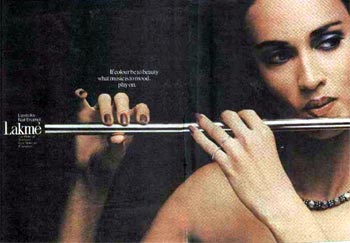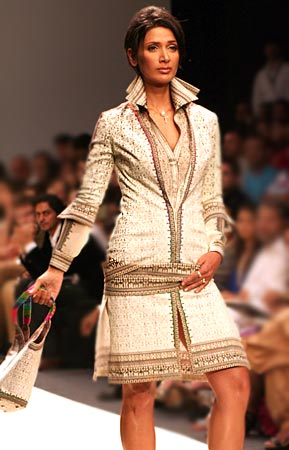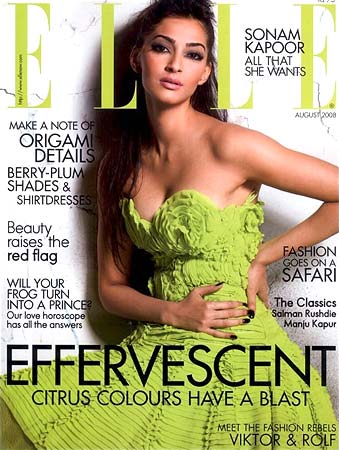
Ace photographer Prabuddha Dasgupta tragically passed away of a heart attack while on assignment in Alibaug, close to Mumbai, yesterday; he was only 58 years old.
As a tribute to the departed artist, whose work was featured in prestigious galleries around the world and won him several awards during his lifetime, we bring you a 2009 interview he gave Arthur J Pais in New York, when his book Edge of Faith, coauthored with William Dalrymple, released.
In the following pages, Dasgupta affords us a glimpse of his versatile persona, his passion for muse and ladylove Lakshmi Menon and the force that drove him to create more than just photographs -- to create art.
He's one of India's most famous fashion photographers and he's dating a supermodel 15 years younger. His new book, The Edge of Faith captures striking images of the Catholic community of Goa and their struggle to balance colonial Portuguese culture with their inherent Indianness, alongside written inputs from travel-writer William Dalrymple. In a tete-a-tete with Arthur J Pais, Prabuddha Dasgupta discusses the commercialisation of the fashion industry today, his relationship with Laxmi Menon and why he prefers not to work with Bollywood personalities. Excerpts from an interview:
You have photographed some of the most interesting models in India. Tell us a little bit about how that works and let's start with Laxmi Menon, your better half...
...And my muse for a long, long time now, even from just a photographer's point of view. When I met her she was just starting out as a model. It's been eight years since then. I was just separated from my wife, so when I met her, it was obviously for a commercial assignment but it was almost like electricity. I don't mean just the man-woman chemistry; I'm talking about just the photographer-subject chemistry. Here was a person who when photographed, brought everything to the universe of what a subject should be, without any effort on my part. It was almost as if there was a kind of invisible connection between the two of us in terms of what I needed in a photograph and what she could deliver as a subject.
Maybe like a movie director and an artist? Not many spoken words but just a kind of understanding.
Exactly. And sometimes, before I could think of the image, she had already become the image. Electricity is the only word to describe it. I've never really photographed anybody except my own children over many, many years, because, you know, it's physically and practically difficult and the subject doesn't stay the same. I never thought, 'This is one person I must keep photographing.' But you know, with Laxmi it's been like that. I mean, eight years down the line I get as much joy out of lifting my camera in her direction and that same shiver up my spine that I did the first time I lifted a camera in her direction.
So in terms of what a model and a photographer relationship could be, I think this one epitomises it. I don't think it could get better than this in terms of what a model can be for a photographer -- being able to have that understanding and that chemistry and that connection, just without any effort. It's effortless. So that's beautiful and it's one of the most wonderful experiences of my life. And beyond that of course, we have now been together eight years and there is no practical, no rational explanation to our relationship.
Initially, when it started to blossom in my own head and everybody around us saw it, everything about it was wrong. Like the huge difference in age -- 15 years. Then I was already married, had children. I was also not the kind of person who could have a relationship with somebody and avoid confronting all the issues surrounding it. Because Laxmi has parents, you know, to deal with and for a parent to think, 'Oh, my God, my daughter is going out with an already married man, he has children' -- I went in prepared for all of it and found that there was no conflict. The conflict was only in my own head. All these barriers that I thought were meant to be and that we're conditioned into believing are nothing. So you can't rationalise the relationship, it's just something that's there and the connection is there. You can't help but embrace it.

Laxmi is here with you in New York. Have you photographed her on this trip? What is one of your favourite pictures?
Yes I've done pictures with her this time but I haven't even looked at them yet because I shoot, you know, waking up in the morning in bed and the room that we're in -- it's become like a long-term effortless project for me, doing pictures with her. Maybe one day when I'm older these will become another book, who knows, which will be called 'Laxmi' (laughs).
Has your Malayali improved? Have you picked up a few words from her?
Yes, yes, Laxmi's fluent and she's very rooted, very strong -- it's a matriarchal society there -- and I'm very proud of her as a person. She's working as a model, she's one of the top international models worldwide now. She does New York, Paris fashion shows, advertising campaigns, but not one bit of it has gone to her head. She still has a square head on her shoulders; she is rooted firmly to the ground, she knows her priorities, her family -- it's amazing. So in that sense, if you're asking about my relationship with models, this has been I think, the strongest and the best and I don't think I'll be able to surpass this.
Tell us about some of the other interesting, challenging models you've worked with?
Well, another woman that comes to mind -- this was I'm talking of 10-12 years ago -- was Shyamolie Verma. I've always gravitated in the work that I do in fashion and with models, towards women who are more than the one-dimensional kind that have now become the norm.
There's a kind of homogeneity in beauty -- beauty has become kind of commodified today. And I can understand the reason for doing that -- if you create one unattainable ideal, which is what you see now on billboards and in magazines and you have the entire planet going towards that single ideal -- it's very easy to sell your products. Because you will never really attain that ideal, so you will forever strive to become something that you see up there that you never will be. So you'll forever be unhappy and you'll keep buying clothes or cosmetics or beauty products or whatever it is to reach that. So in that sense, it's quite a terrifying business, the business of beauty and fashion. And it has become more so, because it's very much in the commercial arena. Beauty is now only about money.
So coming back to Shyamolie Verma, what I was talking about was that I gravitate towards a beauty which is not the beauty in the conventional, one-dimensional way that you see it -- you know, of a symmetrical face, light eyes and straight hair or whatever the current definition of beauty is. For me, it's much bigger than that. There has to be a little quirk, there has to be a certain imperfection, there has to be a certain vulnerability, otherwise that beauty is too perfect and perfect beauty doesn't exist. So Shyamolie Verma was one of those and a striking woman. She was much more than just a model.
Then there were a few others, like Mehr Jesia...

What did you find attractive about Mehr Jesia?
Mehr was, I think, possibly ahead of her time -- those were more conservative times, the early '90s. The idea of a woman's comfort with her own body and the ability to project her sensuality at that time was more of a rarity. The whole idea of being a model back then wasn't so glamorous as it has become now -- now every mother is pushing her daughter towards becoming a model. It's suddenly become respectable. But in the early years when I started out a model was not a person of great moral character and she was what they call 'loose'.
That's an awful Indian expression...
I know! 'Loose character' -- I agree that it's a completely sexist, hypocritical term. Anyway, Mehr was actually the muse of a favourite designer friend of mine who unfortunately died years ago. A man called Rohit Khosla. And the three of us sort of made a team in those years -- we all worked together because we all shared the same energy, we shared the same ideas and dreams. So I think it was more about that, more about being part of that similar kind of energy.
I think more than anything, it was Mehr's ability to get in touch with her sensuality and project it which made me feel this bond with her closer than with others.
What kind of impact did those pictures taken back then with Shyamolie, with Mehr, have on your work today? Any memorable pictures to speak of?
My most memorable photograph of Mehr was again for Rohit Khosla and I still remember the picture completely. I'll just have to describe it because I don't have it here. It was a picture of her in profile and most of what you could see was her neck, going up and it was shot from the side. It was a very simple image but I think sometimes the simplest images have the strongest impact.
And what I think was special about all those girls at that time, those models, was that they had a certain individuality and strength of personality which unfortunately, in today's times, does not seem to be the order of the day. I think the commercial parameters have changed so much -- and this is worldwide, not just in India.

Despite your opinion regarding the difference between the models of yesteryear and today, other than Laxmi Menon, are there any in the present times who match up to your expectations of strong, realistic beauty and personality?
Yes, definitely. There's a girl that I worked with very recently, her name is Monikangana Dutta. She also, strangely enough, is starting to work now in the international circuit and I think she's also getting into the Bollywood industry. I've known of her for a long time, I'd photographed her once before about four years ago and at that time, for whatever reason -- I don't remember why -- I wasn't hugely impressed. But this time when I photographed her I suddenly saw that I had missed something all those years ago. I mean, she has that special kind of beauty that I'm always looking for, that inexplicability, that little thing which cannot be pinned down, that elusive beauty. She has that. That's one.
Then there was somebody else that I recently photographed who was a little unpredictable -- a face which is capable of, with the slightest shift, to create a completely different emotional aura. I don't know if I'm explaining this very well, but it was somebody I was very charmed by recently. She's not a model, she is more of an actress, but she does modelling work and again this homogeneity thing that I was talking about, if it's there in modelling it's even more so in the world of Bollywood. And I'm quite shy of working with Bollywood starlets and people like that because a couple of my experiences, while not unpleasant, haven't been something that I would want to repeat very often either -- the baggage that comes with them in terms of star quality and that universe they seem to inhabit.
But I was very pleasantly and happily surprised when I photographed this young, very talented actress called Sonam Kapoor, Anil Kapoor's daughter. I told her, 'You have a special quality, you have to keep this going.' She has an old-world face and she's very charming, very well brought up, very solid, very rooted. That is a pleasure to encounter in the business.
What did Sonam do for your camera?
I think all of the things I've just said, but most importantly, she has a great sense of self, which she was completely comfortable with. Normally, whenever you confront anybody that makes a living off of their physical appearance, they are usually a little constructed in their posturing, in their projection; you know, 'This is my best side,' and 'I can't laugh like this,' or 'What will my hair look like if it is styled like that?' But Sonam came to it with complete abandon and she was happy to go anyplace in terms of the photographic exchange. There was no self-consciousness, none at all. And coming from somebody who is just at the beginning of her career -- she's ambitious, she wants to do things -- it was such a great pleasure to really encounter that. I told her that repeatedly and we had fun and that's when the photographic project becomes so enjoyable, because both of you are giving it 100 percent and just going with the flow.
Also, as an actress, that quality is going to take her a long way -- to be able to surrender to the director, to be able to just give herself up to somebody else's vison and obviously, it will have to be a vision that she trusts. I think it will be fabulous for her if she can keep this up.

What are you working on right now?
Well, a variety of things. Like I said, because I straddle many universes, this book has taken up a lot of my time, especially the physical making of it. The printer, getting the editing together, the writing, the dialogue with the publisher and all of that has taken up a lot of my time and energy. So right up until I left for New York I was in the throes of going from one commercial assignment or another. And thoroughly enjoying it, because it was completely different from this universe which I inhabited till then, in the last three months.
So that's what I've been doing and then I've also been following this other longterm kind of photographic project which is even more personal -- I've started on a kind of photographic diary of my own. Life, so to speak. The photographs are almost autobiographical, but not in the very literal sense. The work is more abstract and almost kind of non-photographic because I'm almost trying to photograph feelings rather than subjects. Most of the work so far that I've been doing is subject-driven, in the sense that there is either Goa or there is Ladakh or there are women -- there's a particular subject, in a particular physical space. But I'm now trying to do something which is my response to things, people, places, atmospheres and environments to which I respond to strongly. To be able to photograph that and make that a tangible image is a very, very difficult exercise but I'm not trying to force it. I'm trying to do it on my own.
How do you portray feelings in a photograph?
Well I would have to show you because it won't make sense for me to just talk about it. One of the images, one of my favourites from the new series, is a half-blurred picture of a statue of a horse at night, which was actually taken in New York the last time I was here in front of the American Museum of Natural History on the Upper West Side. And I know it doesn't make any sense when I say that because a person who's reading this will say 'What? A blurred picture of a horse at night?' But it's just of my response to that moment -- walking down a particular lane, how I was feeling at that time and I saw this, it looked real, this horse, but it was actually a statue and the streetlights were hitting it in a certain way. It's got a kind of part-dream, part-real kind of quality. It's that kind of stuff that I'm trying to explore; it's very difficult to explain it.